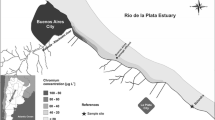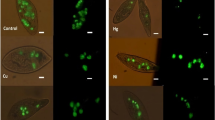Abstract
Uptake of 51Cr(III) is faster than uptake of 51Cr(VI), but it occurs mainly on the surface of the animals. Steady state is attained after 28 d. The resulting concentration factor is about 200. Although the uptake of 51Cr(VI) is slower, it is more intensively distributed into the organs and tissues of the animals. Steady state was not attained during the experiments (35 d); the highest concentration factor reached was about 10. The uptake of both 51Cr(III) and 51Cr(VI) seems to be passive. For both chemical forms of chromium, the loss rate is inversely proportional to the exposure time. When the uptake lasted longer, owing to the distribution of Cr(VI) into the organs and tissues, the loss rate of Cr(III) is somewhat faster relative to the loss rate of 51Cr(VI). The opposite is the case when the uptake of both forms lasts only two days. On the basis of the distribution and loss experiments, we argue that hexavalent chromium in living organisms is reduced to the trivalent form and then complexed with organic molecules.
Similar content being viewed by others
Literature cited
Baudouin, M. P. and P. Scoppa: Accumulation and retention of chromium-51 by freshwater zooplankton. Commission of the European Communities, EUR 516oe, Joint Nucl. Res. Center Ispra Estabilisment. Italy. 2–23, 1974
Bossard, M. J. and S. M. Schuster: Structural preferences for binding of chromium nucleotides by beef heart mitochondrial ATPase. J. Biol. Chem. 256, 6617–6622 (1981)
Brewer, P. G.: Minor elements in sea water. In: Chemical oceanography, vol. 1, pp 415–496. Ed. by J. P. Riley and G. Skirrow. London: Academic Press 1975
Calapaj, R., L. Ciraolo, G. Magazzu and H. Berdar: Contents of mercury, lead, cadmium, chromium, copper, iron and zinc in certain bathyphilic fish and crustaceans from the Straits of Messina. Rev. int. Oceanogr. Med. 51–52, 127–137 (1978)
Chipman, W. A.: Uptake and accumulation of chromium-51 by the clam Tapes decussatus in relation to physical form. In: Disposal of radioactive wastes into seas, oceans and surface waters, pp 571–582. Vienna: IAEA 1966a
Chipman, W. A.: Some aspects of the accumulation of 51Cr by marine organisms. In: Radioecological concentration processes, pp 931–961. Oxford and New York: Pergamon Press 1966b
Christian, G. D. and F. J. Feldman: Atomic absorption spectroscopy: Applications in agriculture, biology and medicine, 490 pp. New York: Wiley and Sons 1970
Descamps, B. and L. Foulquier: Aperçu sur la contamination experimentale d'Anguilla anguilla (L.) par la chrome 51. Report CEA-R-4548. Centre d'Etudes Nucléaires de Saclay Gif-sur-Yvette 1974
Fukai, R. and D. Broquet: Distribution of chromium in marine organisms. In: Radioactivity in the sea, No. 13, p. 19. Vienna: IAEA 1965
Günther, T., B. Ruhe, J. Schmalbeck and N. Tehrani: Biochemistry of trace elements Zn, Cu, Cr and Co: distribution binding and regulation by adrenal hormones. Z. klin. Chem. klin. Biochem. 12, 327–335 (1974)
Marchand, M.: Consideration on the physical-chemical forms of cobalt, manganese, zinc, chromium and iron in sea water, which may or may not be enriched with organic matter. J. Cons. int. Explor. Mer 35, 130–142 (1974)
Naismith, E. F.: The cross-linking of conarachin II with metal salts. Arch. Biochem. Biophys. 73, 255–261 (1958)
Nakayama, E. H., T. Tokoro and T. Fujimaga: Dissolved state of chromium in seawater. Nature, Lond. 290, 768–770 (1981)
Osterberg, Ch., W. G. Pearly and J. Curl: Radioactivity and its relationship to the oceanic food chains. J. mar. Res. 22, 2–12 (1964)
Orzetić, B.: Metabolizam 65Zn raka Xantho hydrophilus (Herbst), Ph.D. thesis, University of Zagreb. Yugoslavia 1971
Polikarpov, G. G.: Radioecology of aquatic organisms, 314 pp. Amsterdam: North-Holland 1966
Pijck, J.: The radiochemistry of chromium, 34 pp. Nucl. Sci. Ser., Nas-Ns 3007, 1960
Ru zić, I.: Two-component model of radionuclide accumulation into marine organisms. I. Accumulation from a medium of constant activity. Mar. Biol. 15, 105–112 (1972)
Sayato, Y., K. Nakamuro, S. Matsui and M. Ando: Metabolic fate of chromium compounds 1. Comparative behaviour of chromium in rat administered with Na2 51Cr O4 and 51Cr Cl3. J. Pharm. Dyn. 3, 17–23 (1980)
Schwartz, K. and W. Mertz: Chromium (III) and the glucose tolerance factor. Arch. Biochem. 85, 292–295 (1959)
Tsapakos, M. J. and K. E. Wetterhahn: The interaction of chromium with nucleic acids. Chem. biol. Interact. 46, 265–277 (1983)
Underwood, E. J.: Trace elements in human and animal nutrition, pp 253–265. New York: Academic Press 1971
Vanbrabant, R. and P. De Regge: Corrosion products in the primary system of PWR as the source of radiation field buildup, pp 435–450. Water Chem. Corr. Probl. Nucl. Power Plants, Proc. Int. Symp. IAEA Vienna 1982
Van der Putte, I. M., A. Brinkhorst and J. H. Koeman: Effect of pH on the acute toxicity of hexavalent chromium to rainbow trout (Salmo gairdneri). Aquat. Toxicol. 1, 129–142 (1981)
Watling, H. R.: Accumulation of seven metals by Crassostrea gigas, Crassostrea margaritacea, Perna perna and Choromytilus meridionalis. Bull. envir. Contam. Toxicol. 30, 317–322 (1983)
Zober, A.: On the problems of evaluating bronchia carcinoma after exposure to chromium compounds. Int. Arch. Envir. Occup. Health 43, 107–122 (1979)
Author information
Authors and Affiliations
Additional information
Communicated by O. Kinne, Oldendorf/Luhe
Rights and permissions
About this article
Cite this article
Peternac, B., Legović, T. Uptake, distribution and loss of Cr in the crab Xantho hydrophilus . Marine Biology 91, 467–471 (1986). https://doi.org/10.1007/BF00392597
Accepted:
Issue Date:
DOI: https://doi.org/10.1007/BF00392597




